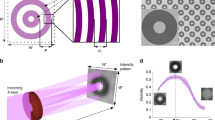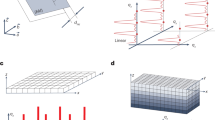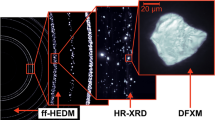Abstract
The contrast and penetrating power afforded by soft X-rays when they interact with matter makes this form of radiation ideal for studying micrometre-sized objects1,2. But although soft X-rays areuseful for probing detail too fine for visible light microscopy in specimens too thick for electron microscopy, the highest-resolution applications of X-ray imaging have been traditionally limited to crystalline samples. Here we demonstrate imaging (at ∼75 nm resolution) of a non-crystalline sample, consisting of an array of gold dots, by measuring the soft X-ray diffraction pattern from which an image can be reconstructed. The crystallographic phase problem3 — the usually unavoidable loss of phase information in the diffraction intensity — is overcome by oversampling4 the diffraction pattern, and the image is obtained using an iterative algorithm5. Our X-ray microscopy technique requires no high-resolution X-ray optical elements or detectors. We believe that resolutions of 10–20 nm should be achievable; this would provide an imaging resolution about 100 times lower than that attainable with conventional X-ray crystallography, but our method is applicable to structures roughly 100 times larger. This latter feature may facilitate the imaging of small whole cells or large subcellular structures in cell biology.
This is a preview of subscription content, access via your institution
Access options
Subscribe to this journal
Receive 51 print issues and online access
$199.00 per year
only $3.90 per issue
Buy this article
- Purchase on Springer Link
- Instant access to full article PDF
Prices may be subject to local taxes which are calculated during checkout




Similar content being viewed by others
References
Kirz, J., Jacobsen, C. & Howells, M. Soft X-ray microscopes and their biological applications. Q. Rev. Biophys. 28, 33–130 (1995).
Sayre, D. & Chapman, H. N. X-ray microscopy. Acta Crystallogr. A 51, 237–252 (1995).
Millane, R. P. Phase retrieval in crystallography and optics. J. Opt. Soc. Am. A 7, 394–411 (1990).
Bates, R. H. T. Fourier phase problems are uniquely solvable in more than one dimension. I: underlying theory. Optik 61, 247–262 (1982).
Miao, J., Sayre, D. & Chapman, H. N. Phase retrieval from the magnitude of the Fourier transforms of non-periodic objects. J. Opt. Soc. Am. A 15, 1662–1669 (1998).
Sayre, D., Kirz, J., Feder, R., Kim, D. M. & Spiller, E. Potential operating region for ultrasoft X-ray microscopy of biological specimens. Science 196, 1339–1340 (1977).
Jacobsen, C. & Kirz, J. X-ray microscopy with synchrotron radiation. Nature Struct. Biol. 5, (synchrotron suppl.), 650–653 (1998).
Jacobsen, C., Kirz, J. & Williams, S. Resolution in soft X-ray microscopes. Ultramicroscopy 47, 55–79 (1992).
Thieme, J., Schmahl, G., Umbach, E. & Rudolph, D. (eds) X-ray Microscopy and Spectromicroscopy (Springer, Berlin, 1998).
Haddad, W. S.et al. Ultra high resolution x-ray tomography. Science 266, 1213–1215 (1994).
Lehr, L. 3D x-ray microscopy: tomographic imaging of mineral sheaths of bacteria Leptothrix ochracea with the Göttingen x-ray microscope at BESSY. Optik 104, 166–170 (1997).
Wang, Y., Jacobsen, C., Maser, J. & Osanna, A. Soft x-ray microscopy with cryo STXM: II. Tomography. J. Microsc.(in the press).
Howells, M.et al. X-ray holograms at improved resolution: a study of zymogen granules. Science 238, 514–517 (1987).
Lindaas, S., Howells, M., Jacobsen, C. & Kalinovsky, A. X-ray holographic microscopy by means of photoresist recording and atomic-force microscope readout. J. Opt. Soc. Am. A 13, 1788–1800 (1996).
Sayre, D. in Imaging Processes and Coherence in Physics (eds Schlenker, M. et al.) 229–235 (Springer, Berlin, 1980).
Sayre, D., Chapman, H. N. & Miao, J. On the extendibility of X-ray crystallography to noncrystals. Acta Crystallogr. A 54, 233–239 (1998).
Fienup, J. R. Phase retrieval algorithm: a comparison. Appl. Opt. 21, 2758–2769 (1982).
Schneider, G. & Niemann, B. in X-ray Microscopy and Spectromicroscopy (eds Thieme, J., Schmahl, G., Rudolph, D. & Umbach, E.) 25–34 (Springer, Berlin, 1998).
Maser, J.et al. in X-ray Microscopy and Spectromicroscopy (eds Thieme, J., Schmahl, G., Rudolph, D. & Umbach, E.) 35–44 (Springer, Berlin, 1998).
Lindaas, S.et al. in X-ray Microscopy and Spectromicroscopy (eds Thieme, J., Schmahl, G., Rudolph, D. & Umbach, E.) 75–86 (Springer, Berlin, 1998).
Acknowledgements
The decision to try oversampling as a phasing technique was arrived at in a conversation in the late 1980s with G. Bricogne. W. Yun and H. N. Chapman also participated in early parts of this experiment. We thank C. Jacobsen for help and advice, especially with the numerical reconstruction, and we thank him and M. Howells for use of the apparatus20 in which the exposures were made; we also thank S. Wirick for help with data acquisition. P.C. thanks the Leverhulme Trust Great Britain for supporting the nanofabrication programme at King's College, London. This work was performed at the National Synchrotron Light Source, which is supported by the US Department of Energy. Our work was supported in part by the US Department of Energy.
Author information
Authors and Affiliations
Corresponding author
Rights and permissions
About this article
Cite this article
Miao, J., Charalambous, P., Kirz, J. et al. Extending the methodology of X-ray crystallography to allow imaging of micrometre-sized non-crystalline specimens. Nature 400, 342–344 (1999). https://doi.org/10.1038/22498
Received:
Accepted:
Issue Date:
DOI: https://doi.org/10.1038/22498
This article is cited by
-
Local-orbital ptychography for ultrahigh-resolution imaging
Nature Nanotechnology (2024)
-
Direct observation of single-atom defects in monolayer two-dimensional materials by using electron ptychography at 200 kV acceleration voltage
Scientific Reports (2024)
-
On the use of deep learning for phase recovery
Light: Science & Applications (2024)
-
Ultrafast Bragg coherent diffraction imaging of epitaxial thin films using deep complex-valued neural networks
npj Computational Materials (2024)
-
Accurate real space iterative reconstruction (RESIRE) algorithm for tomography
Scientific Reports (2023)
Comments
By submitting a comment you agree to abide by our Terms and Community Guidelines. If you find something abusive or that does not comply with our terms or guidelines please flag it as inappropriate.



